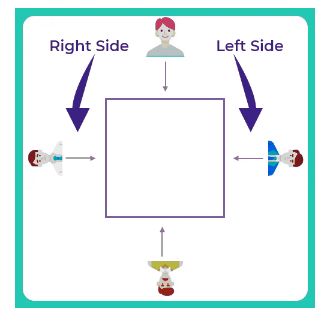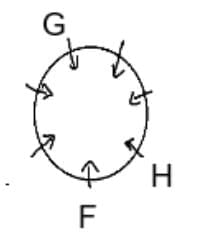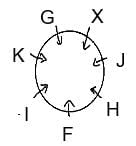Important Formulas: Seating Arrangements | Reasoning Aptitude for Competitive Examinations - Bank Exams PDF Download
Definition
A seating arrangement refers to the organized placement of individuals, objects, or elements in specific positions according to provided conditions or constraints.
Seating Arrangement Techniques
1. Facing Center:
- Towards Left: Clockwise Rotation.
- Towards Right: Anticlockwise Rotation.
2. Facing Outwards:
- Towards Left: Anticlockwise Rotation.
- Towards Right: Clockwise Rotation.
Types of Seating Arrangements
1. Linear Seating Arrangement:
- Arrangement in a single row, requiring placement based on specified conditions.
2. Double Row Seating Arrangement:
- Involves two groups seated in two rows, facing each other. Rows typically face North and South directions.
3. Circular Seating Arrangement:
Arrangement around a circular table, with variations:
- Facing the center of the table.
- Facing outward of the table.
- The mix of facing center and facing outward.
Square/Rectangular Seating Arrangement:
- Arrangement around a square/rectangular table, similar to circular seating arrangement, involving inward, outward, or mixed facing questions.
Formulas for Seating Arrangement
1. Linear Seating Arrangement:
- Adjacent Seats: Treat two individuals sitting next to each other as a single unit for arrangement purposes.
2. Circular Seating Arrangement:
- Clockwise and Counterclockwise: Keep track of both clockwise and counterclockwise positions.
3. Rectangular Table Seating:
- Rows and Columns: Identify rows and columns for better organization.
- Facing Each Other: Individuals facing each other occupy opposite corners.
4. Grouping and Arrangement:
- Clusters or Groups: Form clusters based on related conditions.
- Group Arrangements: Arrange individuals within the group as per specific conditions.
5. Fixed Positions and Constraints:
- Fixed Elements: Place elements with fixed positions first as reference points.
- Using Constraints: Utilize given constraints to eliminate invalid positions and refine the arrangement.

Solved Questions on Seating Arrangements
Q1: Vishu, Pooja, Vishakha, Rani, and Ram are sitting in a line. Pooja is third to the extreme right end. Vishu is second to the left of Pooja. Vishakha is to the right of Pooja. Rani is third to the right of Ram, who is the immediate neighbour of Vishu. Who is sitting in the middle?
(a) Pooja
(b) Ram
(c) Vishakha
(d) Rani
Ans:(a)
Sol:
Pooja is third from the extreme right end.
In a row of five seats, counting from the right, the third seat from the right is position 3.
So, Pooja sits in position 3.
Vishu is second to the left of Pooja.
Two seats to the left of position 3 is position 1.
So, Vishu sits at the extreme left end.
Rani is third to the right of Ram, who is the immediate neighbour of Vishu.
Vishu is at position 1 → his immediate neighbour is position 2 → Ram sits here.
Counting three seats to the right of Ram (position 2 + 3) gives position 5 → Rani sits at the extreme right end.
Vishakha is to the right of Pooja.
The only empty seat to the right of Pooja (position 3) is position 4 → Vishakha sits here.
Final arrangement:
| Vishu | Ram | Pooja | Vishakha | Rani |
Middle seat: Position 3 → Pooja
Q2: Five planes, A, B, P, Q, and R were saluting on Independence Day in such a way that R was second to the left of Q but to the immediate right of A. There was one plane between B and P. B was not at any of the ends. P and Q were neighbors. Who was at the left end?
(a) A
(b) B
(c) R
(d) Q
Ans: (a)
Sol:
R’s position relative to Q and A
R is second to the left of Q, so Q sits two seats to the right of R.
R is also immediately to the right of A, so A sits immediately to R’s left.
One plane between B and P
There must be exactly one plane separating B and P.
P and Q are neighbors, so P must sit next to Q.
The only empty seats are positions 3 and 5:
If P sits next to Q at position 5, then B sits at position 3 (one seat between B and P).
B cannot be at an end
Position 3 is not an end → B sits here.
A | R | B | Q | P
Left end: A
Q3: Ali, Bob, Carol, Dave, Elma and Frank are sitting around a circular table facing the centre. Ali sits second to the left of Bob. Carol sits third to the right of Bob. Dave sits to the immediate left of Carol. Elma sits to the immediate left of Bob. How many people sit between Elma and Frank when counted from the right of Elma?
(a) Two
(b) Zero
(c) One
(d) Three
Ans: (c)
Sol:
Given:
Ali, Bob, Carol, Dave, Elma and Frank are sitting around a circular table facing the centre.
Ali sits second to the left of Bob.
Carol sits third to the right of Bob.
Dave sits to the immediate left of Carol.
Elma sits to the immediate left of Bob.Thus , one people sit between Elma and Frank when counted from the right of Elma.
Hence, the correct ans is Option 3
Q4: F, G, H, I, J, K and X are sitting around a circular table facing the centre of the table. H sits to the immediate right of F. Only three people sit between H and G when counted from the left of H. X sits third to the right of F. I sits to the immediate right of K. How many people sit between J and K when counted from the left of K?
(a) Two
(b) Three
(c) Four
(d) One
Ans: (a)
Sol:
F, G, H, I, J, K and X are sitting around a circular table facing the centre of the table.
1. H sits to the immediate right of F.
2. Only three people sit between H and G when counted from the left of H.
3. X sits third to the right of F.
4. I sits to the immediate right of K.
After positioning X, K and I only one position is left which will be occupied by the only person left i.e. J.
Thus, two people sit between J and K when counted from the left of K.
Hence, "Option 1" is the correct answer.
|
73 videos|122 docs|124 tests
|
FAQs on Important Formulas: Seating Arrangements - Reasoning Aptitude for Competitive Examinations - Bank Exams
| 1. What are the basic types of seating arrangements in competitive exams? |  |
| 2. How do you calculate the number of ways to arrange 'n' people in a straight line? |  |
| 3. What is the formula for circular seating arrangements? |  |
| 4. How do you approach problems involving restrictions in seating arrangements? |  |
| 5. Can you explain the concept of "block seating" in seating arrangements? |  |























